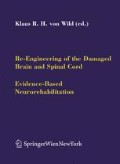Summary
My work in Neurotraumatology was initiated in 1961, when I as a neuropsychologist got a position in a neurosurgical University department. The tasks were to evaluate the mental state of patients, give advices to family members regarding the mental and social prognosis of the patients and to support nurses in the initial care of the patients. Initially the methods that were made use of were tests developed by the German neurologist Kurt Goldstein [8] and traditional psychometric tests, but it was not until the theories of A. R. Luria and his investigation method were applied that a true position as a member of the treatment team was secured. Reading Luria’s book “Higher Cortical Functions in Man” [9] made me aware of his theories. The skill to perform the investigation was acquired during visits to Luria’s laboratory at the Bourdenko Neurosurgical Institute in Moscow in the nineteen-seventies. Text and material to “Luria’s Neuropsychological Investigation” was published in 1974 [1].
The early work was further stimulated by the development in the neurosciences regarding brain plasticity and brain repair [6] and experiences from visits to rehabilitation centres in the US, Yehuda Ben-Yishay’s center at New York Medical School, George Prigatano’s centre at the time in Oklahoma, and Lance Trexler’s center at Community Hospital, Indianapolis led in 1985 to the establishment of the first post acute rehabilitation center in Europe: the Center for Rehabilitation of Brain Injury (CRBI) at the University of Copenhagen, DK [2]. The main program was a holistic day program, six hours a day for four months in accordance with the university semesters, and an eigth months follow-up. Groups of 15 persons started together, collaborating in smaller groups. The present director of the CRBI is neuropsychologist Frank Humle.
A thorough follow-up of the patients’ state and improvement through the course of treatment towards social integration, including getting back to work was performed, and studies have indicated that successful integration of the traumatized patient is possible, provided that an early intensive care is succeeded by a comprehensive, individualized post-acute rehabilitation program, of which follow-up is a part, all within the frame of multidisciplinary collaboration.
Access this chapter
Tax calculation will be finalised at checkout
Purchases are for personal use only
Preview
Unable to display preview. Download preview PDF.
References
Christensen AL (1974) Luria’s Neuropsychological Investigation, 2nd edn., Munksgaard
Christensen AL, Humle F (2004) Holistic Neuropsychological Rehabilitation (in press)
Christensen AL, Randrup Jensen L, Risberg J (1989) Luria’s Neuropsychological and Neurolinguistic Testing. J Neurolinguistics 4(1): 137–154
Christensen AL, Pinner EM, Møler Pedersen P, Teasdale TW, Trexler LE (1992) Psychosocial outcome following individualized neuropsychological rehabilitation of brain damage. Acta Scandinavica Neurol 85: 32–38
Edelmann GM, Mountcastle VB (1978) The mindful brain. Plenum Press, New York
Finger S, Stein DG (1982) Brain damage and recovery. Academic Press
Fuster JM (2003) Cortex and mind, unifying cognition. Oxford University Press, New York
Goldstein K (1942) Aftereffects of brain injury in war. Grune and Stratton, New York
Luria AR (1965) Higher cortical functions in man. Basic Books, New York
Mehlbye J, Larsen A (1994) Social and economic consequences of brain damage in Denmark. In: Christensen AL, Uzzell BP (eds) Brain injury and neuropsychological rehabilitation, international perspectives. Lawrence Erlbaum Ass, Hillsdale New Jersey
Newcombe F (1996) Very late outcome after focal wartime brain wounds. J Clin Exp Neuropsychol 18(1): 1–23
Siert LM (1999) Maintaining people in the work market subsequent to having acquired brain injury due to illness or accident — description of the support person model project. Frederiksborg County, DK
Author information
Authors and Affiliations
Editor information
Editors and Affiliations
Rights and permissions
Copyright information
© 2005 Springer-Verlag
About this paper
Cite this paper
Christensen, A.L. (2005). Neuropsychological experiences in neurotraumatology. In: von Wild, K.R.H. (eds) Re-Engineering of the Damaged Brain and Spinal Cord. Acta Neurochirurgica Supplementum, vol 93. Springer, Vienna. https://doi.org/10.1007/3-211-27577-0_34
Download citation
DOI: https://doi.org/10.1007/3-211-27577-0_34
Publisher Name: Springer, Vienna
Print ISBN: 978-3-211-24150-9
Online ISBN: 978-3-211-27577-1
eBook Packages: MedicineMedicine (R0)

